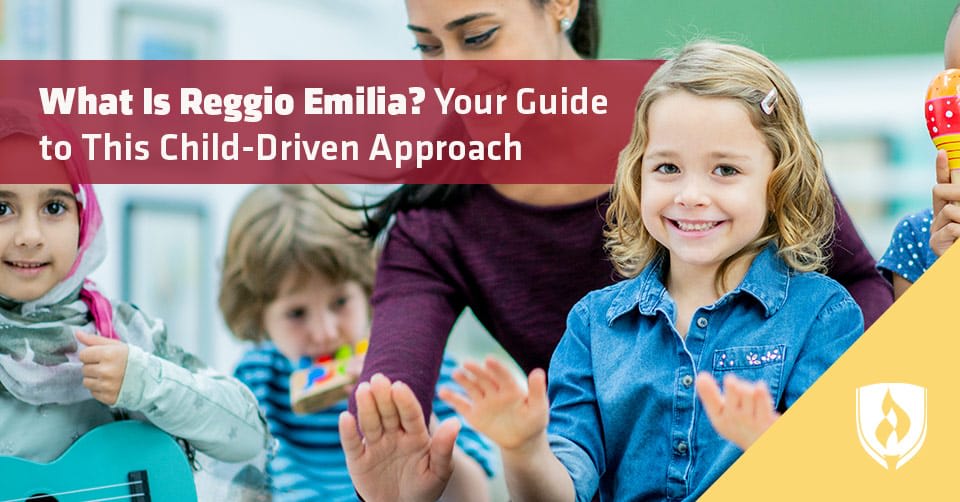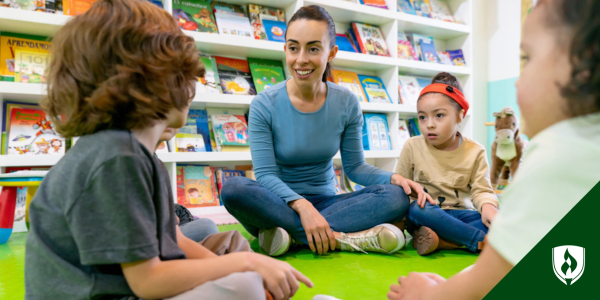
Researching early childhood education (ECE) programs can be a pretty monumental task. Everyone seems to have an opinion about childcare—and a strong opinion at that. But tab over to the Reggio Emilia provider sites and you’ll see beautiful words in creative fonts, accented with pictures of smiling children playing with natural elements in a bright classroom.
The reason for those lovely images goes far deeper than aesthetic style. “A Reggio-inspired model treasures the many ways children explore their worlds and express themselves,” says Chelsea Meyers, ECE educator at Hilltop Children’s Center. Meyers says a shorthand reference for the Reggio Emilia philosophy is “the hundred languages,” a belief that children use art, language, physicality, experimentation, relationships and so many other avenues as forms of communication and expression.
“When we honor those hundred languages, we see our children’s learning and development in layered ways, and the child comes into sharper focus as a community member and a learner,” Meyers says.
If you love children, it’s easy to see the beauty in that description. But if you are trying to understand schools for your child or if you are interested in teaching and education yourself, you’ll want details. How does the Reggio Emilia philosophy translate into a day-to-day classroom setting? What makes it different for young learners? For teachers?
We asked ECE experts in Reggio-inspired education to fill this picture with a little more color.
What is Reggio Emilia?
Broadly speaking, Reggio Emilia is an approach to early childhood learning named after the town where it originated in Italy. Founder Loris Malaguzzi believed children were in need of a more holistic kind of education after World War II. He began the Reggio Emilia style based on the belief that every child is unique and will express their interests in many different ways.
This belief has practical impact, creating a co-learning environment where teachers learn with the children and work in a lateral relationship as opposed to a hierarchical one. That partnership is also intended to encompass the parents and community of each child.
Reggio Emilia also revolves around the children’s senses, relying on sight, sound, touch and even taste and smell to assist with learning. As a result, Reggio Emilia classrooms tend to look different than your average preschool with large common spaces, natural elements and lots of accessible and curiosity-sparking materials.
Today, many schools describe themselves as Reggio-inspired. Meyers says this is because the Reggio Emilia approach is intended to adapt to the children in the room—it’s about them, their specific families and their communities, not a structured model. “The emphasis on community in a Reggio approach means that you need to truly represent your community—not Reggio Emilia, Italy,” Meyers says.
“Officially, unlike Montessori, there aren’t organizations or agencies that certify a school as a ‘Reggio school.’ Identifying as Reggio-inspired holds us educators accountable to turn towards our families and children when developing our environments and curriculum.”
The four principles of the Reggio Emilia approach
You could easily make this educational philosophy a lifelong study, but there are four central principles guiding teachers in Reggio Emilia.
Emergent curriculum
This means essentially that the curriculum for the classroom is a mashup of the children’s interests, their families’ communication, and the close observation and notes teachers take on their students’ growth and exploration. Teachers conduct planning sessions to compare their notes and decide on projects and materials.
In-depth projects
If you are like many, your early education memories involve trying to sit still in desks facing the front of the room where a teacher presented material. But in Reggio Emilia, the learning is led by each child, and structured around projects. Teachers often call these projects “adventures” to young learners. They might last a week or two—or they might extend the entire school year. Teachers guide the children in choosing an area of research and following it to the project’s conclusion.
“What sets Reggio Emilia apart is its emphasis on student projects,” says Emily Horton of GVEOE. When students show interest in a topic, teachers create projects to encourage that interest. They keep documentation in a portfolio for each child throughout the year, allowing them to track individual development.
Representational development
The Reggio Emilia approach invites children to present their ideas and learning in many forms: print, art, drama, dance, music, puppetry, and so on. The belief that learning and growth can take many forms is also an issue of equity for Meyers. “A child may be more drawn to dancing to tell their stories than drawing, for example, and there is room in a Reggio approach to be excited about that and help them translate that strength into new areas.”
“Children can demonstrate their ideas in many different ways: dance, paint, wire, clay, pencil, nature materials...other than just number and letter,” says Marty Watson, director of the Dodge Nature Center, a Reggio-inspired preschool. Giving the space for all of these efforts to flourish helps each child build confidence and excitement about their learning.
Collaboration
In a Reggio-inspired classroom, teachers encourage groups to work together using dialogue, comparisons, negotiations and respect. Basing the course of study on the children's interests creates a collaborative environment that can help foster growth. “The children negotiate with the teachers on which interests will be studied,” says Nancy Farber, director of Reggio school Cushman Scott. She explains that asking the children to help direct the course of learning allows them to feel heard and respected, and encourages their sense of self-worth.
The Reggio Emilia classroom environment
Many of the gorgeous Reggio-inspired classrooms you might see online look a little like the inside of a nice house. Big windows spill daylight onto a kitchen area, lots of big rugs, bookshelves with natural play items, etc. The structure is often more like pods and areas than rows of desks.
While a big, bright and magical space would inspire anyone, most classrooms don’t have those architectural luxuries. As in other ways, the Reggio Emilia approach is less about the surface look and more about what is really happening between kids, families and teachers.
“A Reggio Emilia inspired environment is for the children that use it,” Meyers says. “It’s an environment that the child can affect and that tells each child they belong there.” Meyers says it’s a priority to keep materials accessible and durable so children can explore in an open-ended way.
“There’s definitely an emphasis on natural materials which, for me, is a call back to the natural motivation to explore and learn of childhood,” Meyers says. “Consider sensory input—what balance do your children need in regards to scent, colors, risk opportunities, textures, different height levels, noise volumes—and what do they need in a small group work space versus an imaginative play space?”
No matter what resources Reggio-inspired teachers have to work with, they consider every element of the space thoughtfully to create an atmosphere where children can feel a sense of agency and creativity.
What does it take to be a Reggio Emilia teacher?
This system of learning puts great emphasis on observation and adaptability in its teachers. While it makes a great fit for some, it’s not for everyone. “A circle discussion may lead the day into an entirely different focus,” Farber says, adding that teachers who love spontaneity and are flexible with change tend to thrive.
“As a Reggio inspired teacher, I need to be able to reflect and take risks,” Meyers says. “We know that children learn through play. A Reggio inspired teacher is an advocate for their students’ play and self-determined goals.” She says the role includes going beyond the surface of what you see your students doing to consider the themes, developmental events, challenges and questions children are exploring.
“A teacher who is curious and values children’s contributions will find a Reggio-inspired classroom very gratifying.” Teachers who specialize in Reggio Emilia will obviously have the option of working at Reggio-inspired schools, but they might also find a great fit with many types of schools.
Even without being in a Reggio environment, teachers who love the Reggio Emilia approach can find ways to incorporate those values. Meyers advises looking for a school that clearly empowers both children and educators to create meaningful experiences for themselves.
“For example, one thing that drew me to my center was a program that gave educators time and even funds to work on projects that addressed gaps they saw,” Meyers says. “Children are also engaged in productive work like helping prepare food for snack or sifting the woodchips out of the sand in the sandbox. We are all capable citizens of our community with value to add.”
Go deeper into early childhood education
While a Reggio Emilia approach does find inspiration in sensory detail and aesthetics, Meyers emphasizes that it does not rely on surface appearances to create community. “If you are valuing a certain pretty outcome over a meaningful exchange between child and a material, then that project isn’t serving your students.”
“A Reggio inspired educator is intentional and responsive so my best advice is to make space for honest reflection and conversation so that you know why you’re doing what you’re doing and you also are ready to be engaged and curious when none of the children approach the material like you thought they would.”
Now you have at least an introductory answer to what is Reggio Emilia, but this is only the tip of the iceberg. Reggio Emilia could be the ideal learning approach for your little one—or the ideal working environment for someone like you, someone who believes children really do have a hundred languages.
Regardless of the approach, ECE plays a crucial role in developing the minds of the future. Learn more about its impact in our article, “5 Reasons Why the Importance of ECE Is Impossible to Ignore.”
EDITOR’S NOTE: This article was originally published in 2015. It has since been updated to include information relevant to 2020.




